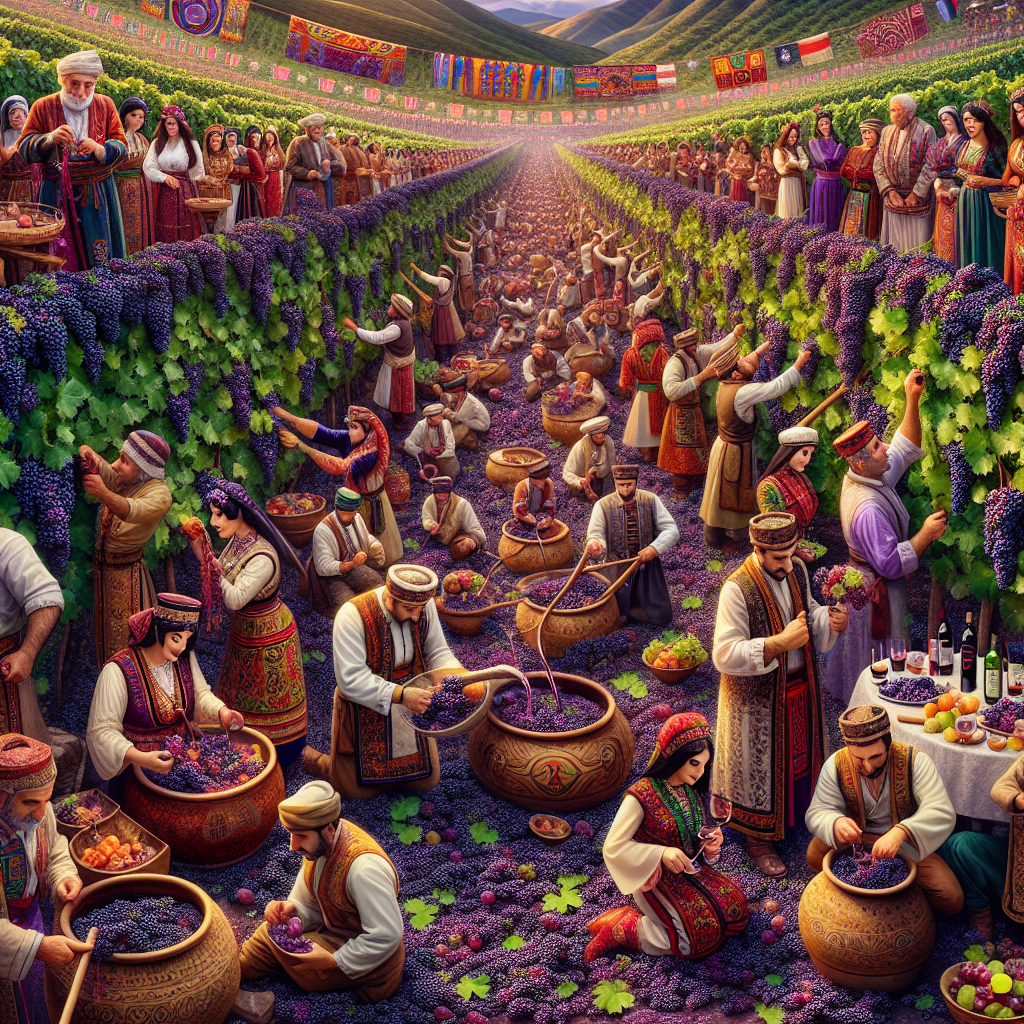The Armenian Grape Harvest Celebration, known locally as “Areni Wine Festival,” is a cultural and traditional event that holds significant importance in Armenia. This annual event is a grand celebration of the grape harvest, highlighting the rich winemaking history that Armenia prides itself on.
Armenia, often referred to as the “land of the vineyards,” is one of the oldest wine producing regions in the world. Hence, the Armenian Grape Harvest Celebration is not just a festival, it’s a tribute to an age-old tradition that has been passed down through generations. Each year, locals and tourists alike gather in the village of Areni in the Vayots Dzor region to partake in the festivities.
All these elements combine to make the Armenian Grape Harvest Celebration a unique and immersive experience, providing a fascinating insight into Armenia’s rich cultural heritage, long-standing traditions, and its enduring love for wine. Witnessing this event first-hand is a must for every wine lover and cultural enthusiast.
Historical Context and Origins of the Armenian Grape Harvest Celebration
The Armenian Grape Harvest Celebration, also known as “Gini”, has deep roots in the ancient history of Armenia. With a wine-making tradition that dates back to 4100 BC, Armenia is considered one of the oldest wine-producing regions in the world. It is believed that the Armenian Grape Harvest Celebration first originated from these ancient wine-making traditions.
The festival is held every year in the Vayots Dzor region of Armenia, where the oldest winery in the world was discovered. The celebration of the grape harvest is not just a festival, but a cherished tradition, deeply rooted in the agriculture-based culture and economy of ancient Armenia. The festival marks the end of the grape harvest season and the beginning of the wine production process.
Cultural Importance of the Armenian Grape Harvest Celebration
The Armenian Grape Harvest Celebration is of great cultural and economic importance to the people of Armenia. Grapes are not only a major agricultural product but are also considered a symbol of fertility and prosperity. The festival is a time for Armenians to express their gratitude for the year’s harvest, and to pray for a prosperous year ahead.
Furthermore, the celebration is an opportunity for Armenians to showcase their ancient wine-making techniques, and to promote their local wines to the world. In recent years, the festival has attracted tourists from around the globe, contributing to the growth of the local wine industry and the national economy.
How the Armenian Grape Harvest Celebration is Celebrated
The Armenian Grape Harvest Celebration is a joyous occasion filled with music, dance, and merriment. The festival begins with the ceremonial picking of grapes, followed by the grape-crushing process where participants stomp on the grapes with their bare feet in large traditional wine vats.
Traditional Armenian music and dances play a crucial role in the celebration. Musicians play traditional instruments such as the duduk and tar, while dancers in colorful traditional costumes perform Armenian folk dances. The festival also features a variety of local food, including traditional Armenian barbecue, known as khorovats, and of course, an abundance of wine.
The highlight of the festival is the wine-tasting event, where visitors have the opportunity to sample a variety of wines from local wineries. The celebration concludes with a spectacular fireworks display, lighting up the Armenian sky, and leaving participants with unforgettable memories of the Armenian Grape Harvest Celebration.
Armenian Grape Harvest Celebration
This blog post is dedicated to the vibrant Armenian Grape Harvest Celebration, a traditional festival that symbolizes the end of the grape harvest season. The celebration is filled with traditions and rituals that have been passed down through generations, creating a unique cultural experience.
Key Activities of the Armenian Grape Harvest Celebration
Grape Harvesting
The main activity of the Armenian Grape Harvest Celebration is grape harvesting. The community comes together to pick grapes from vineyards, marking the end of the grape-growing season. This is a community effort that involves everyone, from children to the elderly.
Wine Making
After the grapes are harvested, they are used to make wine, a process that is central to the celebration. Traditional methods of wine making are used, with families using recipes that have been handed down through generations.
Festive Parade
The celebration also features a festive parade. This includes traditional Armenian music, folk dances, and costumes, showcasing the rich cultural heritage of Armenia.
Rituals and Traditions of the Armenian Grape Harvest Celebration
Offering of the First Fruits
One of the key rituals of the Armenian Grape Harvest Celebration is the offering of the first fruits. The first harvested grapes are offered to God in a ceremony that expresses gratitude for the harvest.
Blessing of the Wine
Another important ritual is the blessing of the wine. After the grapes are harvested and the wine is made, it is blessed in a ceremony. This ritual signifies the importance of wine in Armenian culture and religion.
Feast of the Harvest
The celebration culminates in a feast where the harvested grapes and wine are shared among the community. Traditional Armenian dishes are prepared and enjoyed, accompanied by the newly made wine.
In conclusion, the Armenian Grape Harvest Celebration is a vibrant and meaningful event that celebrates the end of the grape harvest. It is a time for the community to come together and participate in traditional activities, rituals, and traditions, making it an integral part of Armenian culture.

The Armenian Grape Harvest Celebration, or “Rtveli”, is deeply woven into the cultural tapestry of Armenia. As a nation with a rich history of viticulture, the grape harvest season bears a significant role in the country’s traditions, economy, and community spirit.
The Armenia Festival Armenian Grape Harvest Celebration is a time of communal cooperation, where people come together to pick, press and celebrate the season’s ripe grapes. This event is a testament to the country’s enduring agricultural practices and communal values.
The Cultural Armenia Armenian Grape Harvest Celebration showcases the deep-rooted wine culture in Armenia, with the tradition of grape harvesting dating back to over 6,000 years. The celebrations also include folk music, dancing and feasting on traditional Armenian dishes.
One of the remarkable highlights of the celebration is the preparation of traditional Armenian dishes. Among these is the Lavash Stuffed Dolma, a stuffed grape leaf dish that perfectly complements the season. Another is the Armenian Harissa Porridge, a hearty meal that provides sustenance to participants of the festival.
Amidst the grape harvest festivities, Armenians also take the opportunity to appreciate the natural beauty of their homeland. Lake Arpi National Park is one of the popular destinations during this season, offering a serene backdrop to the vibrant celebrations.
In conclusion, the Armenian Grape Harvest Celebration is more than just an agricultural event; it is a cultural experience that brings communities together, celebrates their rich culinary heritage, and pays homage to the timeless beauty of Armenian landscapes. This celebration is a symbol of the Armenian people’s resilience, unity, and deep respect for their land and traditions.


Comments
One response to “Armenian Grape Harvest Celebration”
This blog post has provided a truly fascinating and comprehensive insight into the Armenian Grape Harvest Celebration. The rich history and cultural significance of this event are evident in every part of the celebration, from the communal grape picking to the traditional wine making, and the festive parade. It’s incredible to think that these practices have been passed down through generations, and continue to hold such importance in Armenian society today.
I particularly appreciated the detailed descriptions of the rituals and traditions of the celebration, such as the offering of the first fruits and the blessing of the wine. These rituals not only highlight the deep reverence Armenians have for their land and its produce, but also their strong sense of community and shared heritage.
It was also interesting to learn about the impact of the festival on